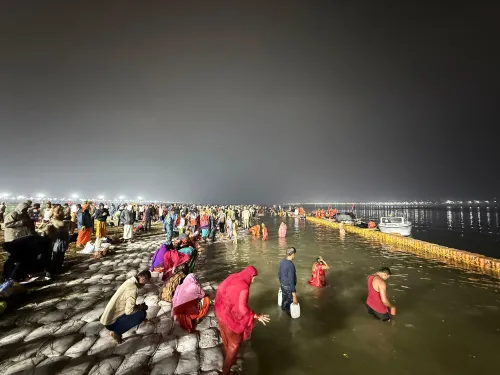IMD Warns of Severe Heatwave in Gujarat Until April 30

Synopsis
Key Takeaways
- Gujarat is experiencing a severe heatwave.
- IMD predicts temperatures between 40-44 degrees Celsius.
- Heat Action Plans have been activated.
- Health advisories encourage hydration and avoiding peak heat.
- Cooling shelters and increased water supply are being implemented.
Ahmedabad, April 25 (NationPress) Gujarat is bracing for a long-lasting and severe heatwave as the India Meteorological Department (IMD) forecasts maximum temperatures soaring between 40-44 degrees Celsius across most areas, especially in the Saurashtra-Kutch region, until April 30.
The IMD's most recent predictions indicate that there will be minimal fluctuations in maximum temperatures over the next three days, followed by an expected increase of 2 to 3 degrees in various parts of the state.
On March 24, Bhuj recorded the highest temperature in the state at 42.7 degrees Celsius, which was an astonishing 4 degrees above the seasonal norm. Rajkot was close behind with 42.2 degrees, 2 degrees above average, and Ahmedabad reached 42.1 degrees, also 2 degrees above normal.
Other cities faced unusually high temperatures: Gandhinagar at 41.6 degrees, Amreli at 41.9, Deesa at 40.8, and Vadodara at 40.4 degrees. In contrast, coastal regions remained relatively cooler. Veraval recorded the lowest maximum temperature at 31.4 degrees, one degree below normal, with Surat noting 35.6 degrees and Porbandar at 35.0 degrees.
These coastal areas were shielded from the harsh inland heatwave due to the sea breeze. Minimum temperatures throughout the state ranged from 27.0 degrees to 20.2 degrees, with Bhavnagar recording the highest and Porbandar the lowest.
Humidity levels varied widely, with morning readings at 48 percent in Ahmedabad, 75 percent in Bhuj, and 69 percent in Amreli. However, the relative humidity sharply declined by the afternoon, exacerbating the dry and severe heat. To tackle the extreme summer temperatures and safeguard citizens from heat-related health issues, the Gujarat government has rolled out several preventive and preparedness initiatives. A key component of these is the activation of Heat Action Plans across different municipal corporations and districts.
These plans, designed in collaboration with the Indian Meteorological Department (IMD) and health authorities, encompass early warning systems, public awareness campaigns, and emergency response protocols to reduce the repercussions of extreme temperatures.
Health advisories have been disseminated via media, radio, and digital channels, urging individuals to remain indoors during peak heat hours, stay hydrated, and be vigilant for signs of heat exhaustion. The government has instructed urban local authorities to establish cooling shelters, including shaded rest areas, water kiosks, and first-aid stations in public venues like bus stations, markets, and construction sites.
Hospitals and primary health centers have been placed on high alert, with designated wards and medical teams ready to address cases of heatstroke and dehydration. School schedules in many regions have been modified, and outdoor activities have been limited to protect children from direct heat exposure.
Furthermore, reports indicate that the Gujarat government is collaborating with civic bodies to guarantee a continuous water supply, particularly in heat-sensitive and drought-affected areas. The supply of tanker water has increased in rural regions where sources are depleting due to rising temperatures. Power utilities have also been directed to manage loads effectively to avert electricity outages, especially during peak hours, ensuring that fans, coolers, and air-conditioning systems function reliably.










